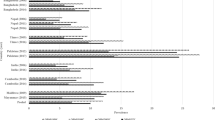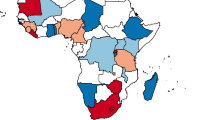Abstract
A double burden of malnutrition (DBM) is the coexistence of under-nutrition and over-nutrition in a single household that has been reported from many developing countries. We performed a secondary analysis on India Human Development Survey (IHDS-II) data assessing ‘stunted child and overweight/obese mother (SCOWT) pairs’ in Kerala households. We included 344 pairs of children below 5 years of age and their mothers, with anthropometric measurements. We also performed the Pearson’s Chi–square test to study the association of SCOWT pairs with socio-economic variables. The prevalence of SCOWT pairs was 10.7% for Kerala. The bivariate analysis showed no significant association for SCOWT pairs, irrespective of their socio-economic status. It is clear that the DBM is prevalent in Kerala and cannot be addressed exclusively by policies focusing on over-nutrition.
Similar content being viewed by others
References
Roger S, Claudia R. The double burden of malnutrition: a review of global evidence. Health, nutrition and population discussion paper. Washington, DC: World Bank; 2012. https://openknowledge.worldbank.org/bitstream/handle/10986/27417/795250WP0Doubl00Box037737900PUBLIC0.pdf?sequence=1&isAllowed=y. Accessed 15 Nov 2018.
WHO. Double burden of malnutrition. 2018. http://www.who.int/nutrition/double-burden-malnutrition/en/. Accessed 7 Aug 2018.
Aigner E, Feldman A, Datz C. Obesity as an emerging risk factor for iron deficiency. Nutrients. 2014;6(9):3587–600.
Shi Z, Hu X, Yuan B, Hu G, Pan X, Holmboe-Ottesen G. Coexistence of anaemia and the metabolic syndrome in adults in Jiangsu China. Asia Pac J Clin Nutr. 2008;17(3):505–13.
Aitsi-Selmi A. Households with a stunted child and obese mother: trends and child feeding practices in a middle-income country, 1992–2008. Matern Child Health J. 2015;19(6):1284–91.
Bassete M, Romaguera D, Giménez M, Lobo M, Samman NC. Prevalence and determinants of the dual burden of malnutrition at the household level in Puna and Quebrada of Humahuaca, Jujuy, Argentina. Nutr Hosp. 2014;29(2):322–30.
Wojcicki JM. The double burden household in sub-Saharan Africa: maternal overweight and obesity and childhood undernutrition from the year 2000: results from World Health Organization Data (WHO) and Demographic Health Surveys (DHS). BMC Public Health. 2014;14:1124.
Ihab AN, Rohana AJ, Manan WMW, Suriati WNW, Zalilah MS, Rusli AM. The coexistence of dual form of malnutrition in a sample of rural Malaysia. Int J Prev Med. 2013;4(6):690–9.
Oddo VM, Rah JH, Semba RD, Sun K, Akhter N, Sari M, et al. Predictors of maternal and child double burden of malnutrition in rural Indonesia and Bangladesh. Am J Clin Nutr. 2012;95(4):951–8.
Kimani-Murage EW, Muthuri SK, Oti SO, Mutua MK, van de Vijver S, Kyobutungi C. Evidence of a double burden of malnutrition in urban poor settings in Nairobi, Kenya. PLoS ONE. 2015;10(6):e0129943.
El Kishawi RR, Soo KL, Abed YA, Wan-Muda WAM. Prevalence and associated factors for dual form of malnutrition in mother-child pairs at the same household in the Gaza Strip-Palestine. PLoS ONE. 2016;11(3):e0151494.
Lee J, Houser RF, Must A, de Fulladolsa PP, Bermudez OI. Socioeconomic disparities and the familial coexistence of child stunting and maternal overweight in Guatemala. Econ Hum Biol. 2012;10(3):232–41.
Parra DC, Iannotti L, Gomez LF, Pachón H, Haire-Joshu D, Sarmiento OL, et al. The nutrition transition in Colombia over a decade: a novel household classification system of anthropometric measures. Arch Public Health. 2015;73(1):12.
Kroker-Lobos MF, Pedroza-Tobías A, Pedraza LS, Rivera JA. The double burden of undernutrition and excess body weight in Mexico. Am J Clin Nutr. 2014;100(6):1652S–8S.
Mahmudiono T, Nindya TS, Andrias DR, Megatsari H, Rosenkranz RR. The effectiveness of nutrition education for overweight/obese mothers with stunted children (NEO-MOM) in reducing the double burden of malnutrition in Indonesia: study protocol for a randomized controlled trial. BMC Public Health. 2016;16:486.
Food and Agriculture Organization of the United Nations, editor. The double burden of malnutrition: case studies from six developing countries. FAO food and nutrition paper. Rome: Food and Agriculture Organization of the United Nations; 2006.
BBC Bitesize. GCSE geography—rapid economic development case study: India—AQA-revision 6. BBC Bitesize. https://www.bbc.com/bitesize/guides/zwf92p3/revision/6. Accessed 28 Aug 2018.
Hubacek K, Guan D, Barua A. Changing lifestyles and consumption patterns in developing countries: a scenario analysis for China and India. Futures. 2007;39(9):1084–96.
Shetty PS. Nutrition transition in India. Public Health Nutr. 2002;5(1A):175–82.
Parikh KS, Ghosh PP, Binswanger-Mkhize HP. Rapid economic growth in India: technical change in agriculture, irrigation and food security. Indian Econ J. 2016;64(1–4):115–36.
International Institute for population Sciences (IIPS), Macro International. National Family Health Survey-4: India fact sheet. 2017. http://rchiips.org/NFHS/pdf/NFHS4/India.pdf.
Desai S, Dubey A, Joshi BL, Sen M, Shariff A, Vanneman R. India Human Development Survey-II (IHDS-II). Ann Arbor, MI: Inter-university Consortium for Political and Social Research; 2015. https://www.icpsr.umich.edu/icpsrweb/DSDR/studies/36151.
Desai S, Vanneman R. ICPSR 22626: India Human Development Survey (IHDS), 2005. Ann Arbor, MI: Inter-university Consortium for Political and Social Research; 2010. https://www.icpsr.umich.edu/icpsrweb/content/DSDR/idhs-data-guide.html.
National Family Health Survey-4 2015–16. State Fact Sheet: Kerala. Mumbai: International Institute for Population Sciences (IIPS) and Macro International; 2017. http://rchiips.org/NFHS/pdf/NFHS4/KL_FactSheet.pdf.
Government of India. Per capita income. 2017. http://pib.nic.in/newsite/PrintRelease.aspx?relid=169546. Accessed 19 Jan 2018.
World Bank. Kerala—poverty, growth, and inequality. Report no. 119248. Washington, DC: The World Bank; 2017. p. 1–5. http://documents.worldbank.org/curated/en/714181504169813713/Kerala-Poverty-growth-and-inequality.
World Health Organization. Description: cut-off points and summary statistics. http://www.who.int/nutgrowthdb/about/introduction/en/index5.html. Accessed 8 Oct 2017.
WHO Expert Consultation. Appropriate body-mass index for Asian populations and its implications for policy and intervention strategies. The Lancet. 2004;363(9403):157–63.
Chaparro C, Oot L, Sethuraman K. Bangladesh nutrition profile. Food and Nutrition Technical Assistance Project (FANTA). Washington, DC: FHI 360; 2014. p. 8.
Malaysia Country Nutrition Profile. 2018 Global Nutrition Report: shining a light to spur action on nutrition. Bristol: Global Nutrition Report; 2018. https://globalnutritionreport.org/nutrition-profiles/asia/south-eastern-asia/malaysia/. Accessed 16 Feb 2019.
UNICEF Malaysia. Children without: a study of urban child poverty and deprivation in low-cost flats in Kuala Lumpur. Putrajaya: UNICEF Malaysia; 2019. https://www.unicef.org/malaysia/FINAL-REPORT-1.pdf.
Sivasankaran S. Nutrition paradox and the evolving health crisis in the State of Kerala, India. Kerala Heart J. 2014;4(2):14–21.
Firoz MC, Banerji H, Sen J. A methodology to define the typology of rural urban continuum settlements in Kerala. J Reg Dev Plan. 2014;3(1):49–60.
Pillai V. Infrastructure, growth and human development in Kerala. Trivandrum: Centre for Development Studies; 2008. https://mpra.ub.uni-muenchen.de/7017/1/Kerala_Infrastructure_Growth_and_HD_MPRA.pdf.
Shergill HS. Living conditions and consumption standard of rural dalits: a comparison across the states. Indian J Hum Dev. 2017;11(1):76–88.
Haddad S, Mohindra KS, Siekmans K, Màk G, Narayana D. “Health divide” between indigenous and non-indigenous populations in Kerala, India: population based study. BMC Public Health. 2012;29(12):390.
Corrie BP. A human development index for the Dalit child in India. Soc Indic Res. 1995;34(3):395–409.
Gittinger JP. Household food security and the role of women. World Bank discussion papers. Washington, DC: World Bank; 1990.
Pérez-Escamilla R. Food security and the 2015–2030 sustainable development goals: from human to planetary health perspectives and opinions. Curr Dev Nutr. 2017;1(7):e000513.
World Bank. Kerala-gender. Washington, DC: World Bank. 2017. http://documents.worldbank.org/curated/en/354551504168713235/pdf/119245-BRI-P157572-Kerala-Gender.pdf.
Mathew SS. Falling female labour force participation in Kerala: empirical evidence of discouragement? Int Labour Rev. 2015;154(4):497–518.
Department of Economics and Statistics. Report on NSS socio-economic survey-64th round: household consumer expenditure, July 2007–June 2008. Government of Kerala; 2012. http://www.ecostat.kerala.gov.in/images/pdf/publications/NSS/data/nss64_hous_con_exp.pdf.
Spatial Poverty in Kerala. 2014. https://www.livemint.com/. https://www.livemint.com/Politics/FJwyzCLIJU1DrOR00aFmDK/Spatial-poverty-in-kerala.html. Accessed 10 Jun 2018.
Nithya NR. Changing trend of consumerism in Kerala. Int J Curr Res. 2013;5(11):3520–3.
Abdulla DMP. Consumerist tendencies in housing sector—a case of misdirected resource allocation. Int J Humanit Soc Sci Invent. 2014;3(3):5–10.
Padma P, Ramasamy EV. Changing trend in household consumption expenditure pattern of Kerala. Sahyadri conservation series. Bengaluru: Centre for Ecological Sciences, Indian Institute of Science; 2014. p. 110–3.
Maneesh P. Impact of food inflation on BPL and APL household consumption—a study in Kannur district, Kerala. Indian J Econ Dev. 2015;3:9.
Saritha C, John J. Food security and balancing food budget of the families by compensatory public distribution system: an analysis with respect to public distribution system in Kerala. IOSR-JESTFT. 2015;9(3 ver.II):21–7.
Bandyopadhyay S. Why is economic growth across Indian states uneven? South Asia@LSE. 2013. http://blogs.lse.ac.uk/southasia/2013/02/18/why-is-economic-growth-across-indian-states-uneven/. Accessed 17 Nov 2018.
Author information
Authors and Affiliations
Corresponding author
Additional information
Publisher's Note
Springer Nature remains neutral with regard to jurisdictional claims in published maps and institutional affiliations.
Rights and permissions
About this article
Cite this article
Jayalakshmi, R., Kannan, S. The double burden of malnutrition: an assessment of ‘stunted child and overweight/obese mother (SCOWT) pairs’ in Kerala households. J Public Health Pol 40, 342–350 (2019). https://doi.org/10.1057/s41271-019-00172-7
Published:
Issue Date:
DOI: https://doi.org/10.1057/s41271-019-00172-7




